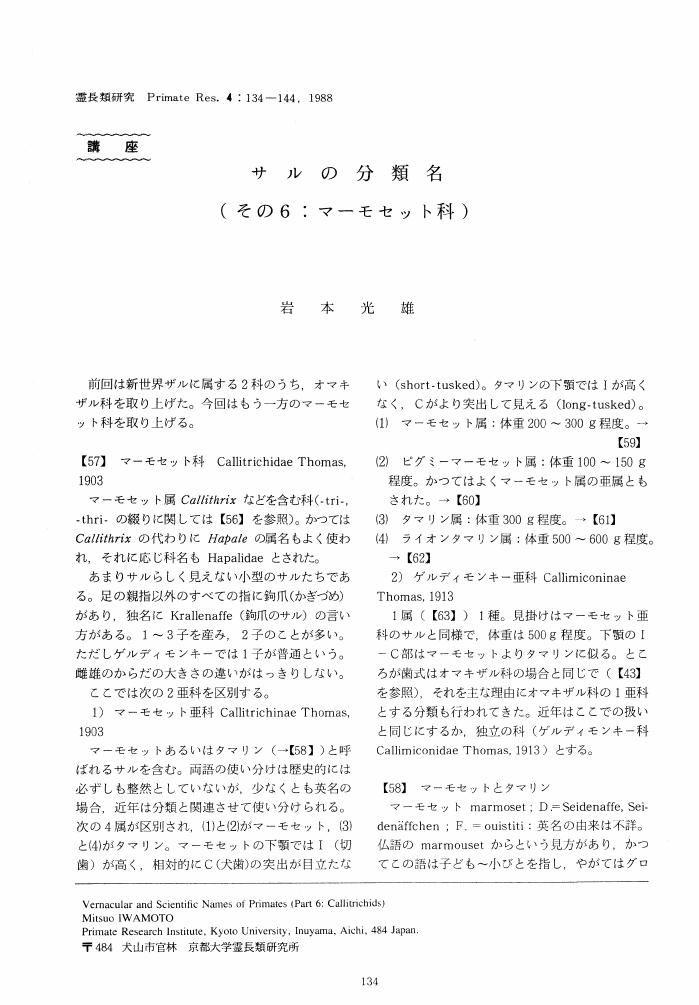2 0 0 0 OA サルの分類名(その1:マカク)
- 著者
- 岩本 光雄
- 出版者
- Primate Society of Japan
- 雑誌
- 霊長類研究 (ISSN:09124047)
- 巻号頁・発行日
- vol.1, no.1-2, pp.45-54, 1985 (Released:2009-09-07)
- 被引用文献数
- 7 3
2 0 0 0 OA サルの分類名(その4:類人猿)
- 著者
- 岩本 光雄
- 出版者
- Primate Society of Japan
- 雑誌
- 霊長類研究 (ISSN:09124047)
- 巻号頁・発行日
- vol.3, no.2, pp.119-126, 1987 (Released:2009-09-07)
- 被引用文献数
- 2 3
2 0 0 0 OA サルの分類名(その2:オナガザル,マンガベイ,ヒヒ)
- 著者
- 岩本 光雄
- 出版者
- Primate Society of Japan
- 雑誌
- 霊長類研究 (ISSN:09124047)
- 巻号頁・発行日
- vol.2, no.1, pp.76-88, 1986 (Released:2009-09-07)
1 0 0 0 OA ニホンザル永久歯の萌出年令
- 著者
- 岩本 光雄 渡辺 毅 浜田 穣
- 出版者
- Primate Society of Japan
- 雑誌
- 霊長類研究 (ISSN:09124047)
- 巻号頁・発行日
- vol.3, no.1, pp.18-28, 1987 (Released:2009-09-07)
- 参考文献数
- 20
- 被引用文献数
- 35 36
A total of 406 observations on dental eruption was obtained from 343 Japanese monkeys (Macaca fuscata) of known birthdays (Table 1).The order of the beginning of eruption was estimated as (M1, M1), (I1, I1), (I2, I2), (M2, M2), (PPPP), (C, , C'), (M3, M3) for male and (M1, M1), (I1, I1), (I2, I2), (M2, M2), (C, , P3, P3, C', P4, P4), (M3, M3) for female.Among 406 observations, 270 were used for statistics of the eruption age, because the remaining 136 which were obtained from monkeys of Shiga and Koshima show a fair degree of delay in the eruption age as a whole. The statistical results were shown in Tables 2 and 3, and a norm of the eruption age as a tentative interpretation was given in Table 4 with a footnote concerning the delay of eruption in monkeys of Shiga and Koshima. Interpretation of the delay in these monkeys is difficult, though the delay in monkeys of Koshima may be related to the general delay of their growth which has been caused by their isolation on a small islet.From the comparison of the present results and related reports on macaques (Table 5), it is apparent that among four species, M. fascicularis, M. mulatta, M. nemestrina and M. fuscata, the eruption is comparatively late in M. fuscata for most teeth, and it is generally earlier in female than male for every tooth except for M3 which erupts at similar age in both sexes or earlier in male than female especially in M. mulatta. Sexual difference in the eruption age of C, and possibly of P3, is relatively small in M. fascicularis and large in M. nemestrina. It seems that these interspecific differences are more or less related to those in body size and canine size.
1 0 0 0 指紋における渦状紋隆線の渦巻き方向について
- 著者
- 岩本 光雄
- 出版者
- 日本人類学会
- 雑誌
- 人類學雜誌 (ISSN:00035505)
- 巻号頁・発行日
- vol.83, no.2, pp.191-202, 1975
渦状紋にその渦状隆線の渦巻き(巻き開く)方向によって3亜型(Wr,Wo,Wu)を区別し,これら3亜型の出現様相を日本人の場合を主とする若干の標本によって検討した。左右手間の側差がいちじるしく,そのため左右対称指間で同亜型が組合う傾向は必ずしも明らかではない。一卵性双生児の対応指間ではその傾向が明らかに認められる。利手との関係は明らかでない。最後に人種差の可能性に関して言及した。
1 0 0 0 OA サルの分類名(その3:コロブスモンキー,ラングールなど)
- 著者
- 岩本 光雄
- 出版者
- 日本霊長類学会
- 雑誌
- 霊長類研究 (ISSN:09124047)
- 巻号頁・発行日
- vol.3, no.1, pp.59-67, 1987 (Released:2009-09-07)





